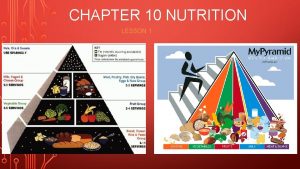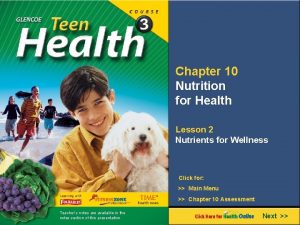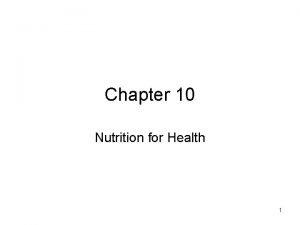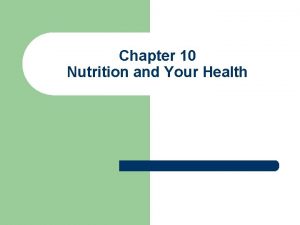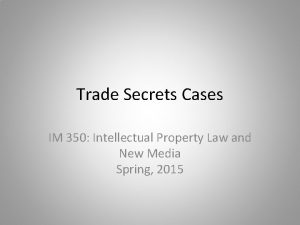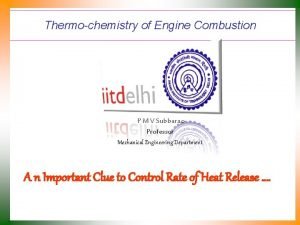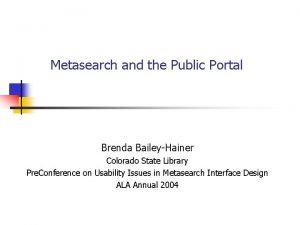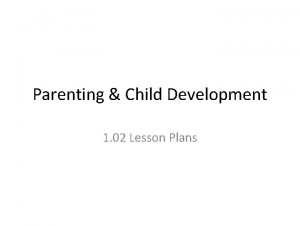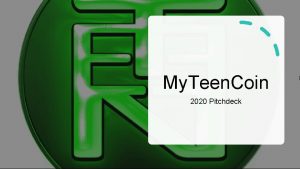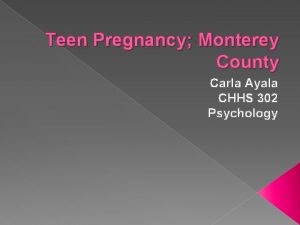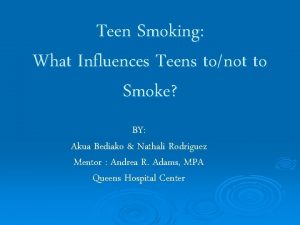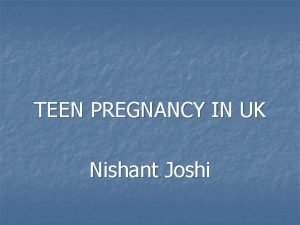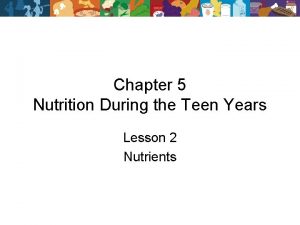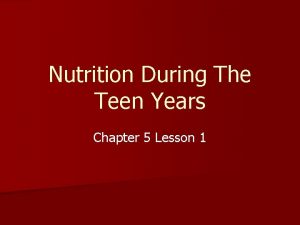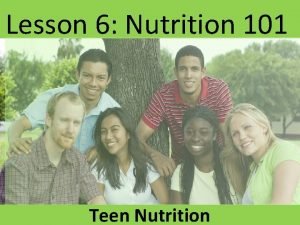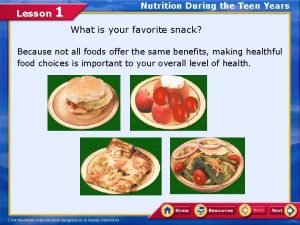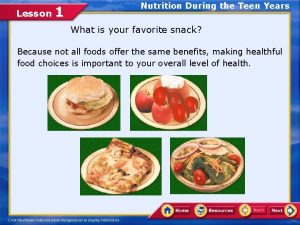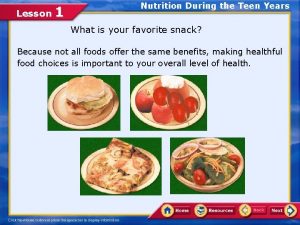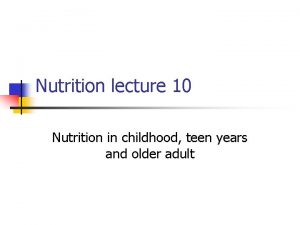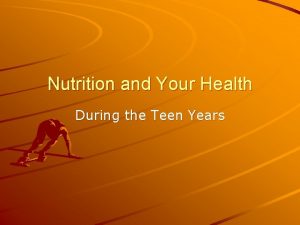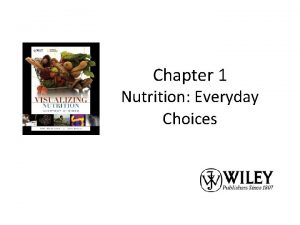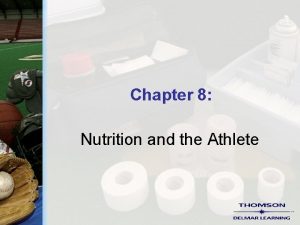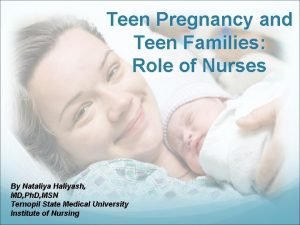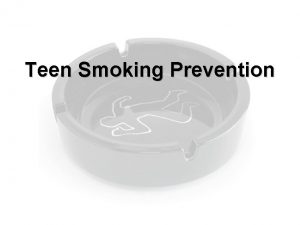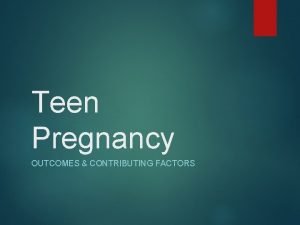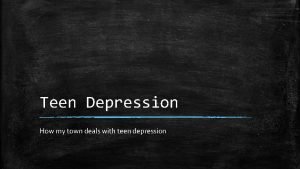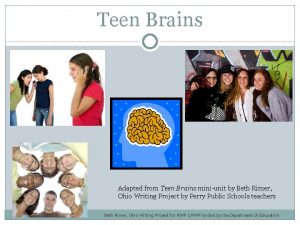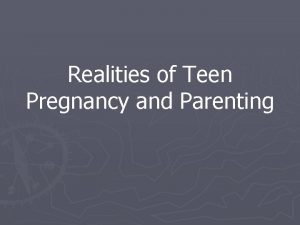Chapter 5 Lesson 1 Nutrition During the Teen
































- Slides: 32


Chapter 5 Lesson 1

Nutrition During the Teen Years Vocabulary: Nutrition Calories Nutrients Hunger Appetite You’ll Learn: • Explain the relationship between nutrition, quality of life, and disease. • Evaluate various influences of food choices. • Explain the immediate and long-term benefits of nutrition on body systems

Nutrition- the process by which the body takes in and uses food. • Good nutrition enhances your quality of life and helps prevent disease. Calories- units of heat that measure the energy used by the body and the energy that food supply to the body. • Nutrients- are substances in food that your body needs to grow, to repair itself, and to supply you with energy.

Hunger- a natural physical drive that protects you from starvation( Physical desire). Appetite- a desire, rather than a need to eat (Psychological desire).

A number of environmental factors influence food choices: • • • Food and emotions Family, friends, and peers Cultural and ethnic background Convenience and cost Advertising

Good Nutrition is essential for health throughout life, but particularly during adolescence-one of the fastest periods of growth.

Chapter 5 Lesson 2

Nutrients Vocabulary: Carbohydrates Fiber Proteins Lipid Vitamins Minerals You’ll Learn To: • Describe the functions of the six basic nutrients in maintaining health • Demonstrate knowledge of nutrients in a variety of foods • Analyze the relationship among good nutrition, health promotion, and disease prevention.

Carbohydrates- are the starches and sugars present in foods. • 4 grams per calorie Simple Carbohydrates- sugars such as fructose and lactose. Complex Carbohydrates- starches in whole grains, seeds, and nuts.

All carbohydrates are converted in to glucose by the body (Stored as glycogen). Fiber- an indigestible complex carbohydrate. • Helps move waste through the digestive system • Prevents constipation

Proteins- are nutrients that help build and maintain body cells and tissues. • Complete Proteins- contain all of the nine essential amino acids. 1. Animal and soybean products • Incomplete Proteins- lacks one or more of the essential amino acids. 1. Beans, peas, nuts, and whole grains

Builds new cells, and tissues from the amino acids in protein. Makes enzymes, hormones, and antibodies. Supplies energy-4 calories per gram

Lipids- a fatty substance that does not dissolve in water. • Saturated fatty acids- holds all the hydrogen atoms it can. Animal and tropical oil fats (solid at room temperature). • Unsaturated fatty acids- liquid at room temperature and associated with a reduced risk of heart disease.

Provides a concentrated form of energy • Transport Vitamins A, D, E, & K. • Development of healthy skin • Diet should consist of 20 to 30 % of fats. Cholesterol- waxy lipid-like substance that circulates in blood to manufacture cell membranes, bile, and nerve tissue.

Vitamins- are compounds that help regulate many vital body processes, including digestion, absorption, and metabolism of other nutrients. • Water soluble-dissolve in water and pass easily into the blood stream during digestion( Vitamin C, B, Niacin, and Folic Acid). • Fat soluble- absorbed, stored, and transported in fat (Vitamin A, D, E, and K). Excess buildup can be toxic.

Mineral- are substances that the body cannot manufacture but that are needed forming healthy bones and teach and for regulating may vital body processes. • Calcium, Phosphorous, Magnesium, and Iron

Water- is vital to every body function. Most abundant nutrient in the body. • Lubricates joints, digestion, absorption, and elements waste.

Chapter 5 Lesson 3

Guidelines for Healthful Eating Vocabulary: Dietary Guidelines for Americans Food Guide Pyramid You’ll Learn To: • Evaluate the concepts of balance, variety, and moderation, using the Food Guide Pyramid and national dietary guidelines • Examine the effects of healthful eating behaviors on body systems • Select healthful meals and snacks as part of a balanced diet.

Dietary Guidelines for Americans- a set of recommendations for healthful eating and active living. • A: Aim for Fitness • B: Build a Healthy Base • C: Choose Sensibly Moderate fat, sugar and salt intake

Importance of Breakfast Nutritious Snacks Eating out/Eating Right

Chapter 5 Lesson 4

Food and Healthy Living Vocabulary: Food Additives Food Allergy Food Intolerance Foodborne Illness Pasteurization Cross-contamination You’ll Learn To: • Utilize the information on food labels. • Develop specific eating plans to meet changing nutritional requirements, such as special dietary needs and food allergies • Analyze the influence of policies and practices on the prevention of foodborne illness • Develop and analyze strategies related to the prevention of foodborne illness.

Nutritional Label/Nutritional Facts Panel • Ingredients List by weight in descending order Food Additives- substances intentionally added to food to produce a desired effect. • Sugar and Fat Substitutes 1. Aspartame- sugar free substitute 2. Olestra- fat free substitute

Nutrient Content Claims Light of Lite- calories reduced by 1/3 Less- 25% less of a nutrient of calorie Free- no fat, sugar, sodium, or calories More- 10% more of a vitamin, mineral, protein, or fiber. • High, rich in, excellent source of- 20% more of a vitamin, mineral, protein, or fiber. • Lean- less than 10 grams of total fat. • •

Reflects freshness • • Expiration date Freshness date Pack date Sell-by date

Food Allergy- a condition in which the body’s immune system reacts to substances in some foods. • Allergens- are proteins that the body responds to as if they were pathogens. • Peanuts, eggs, wheat, soy, fish and shellfish. • Reaction can include rash, hives, itchiness, vomiting, diarrhea, or abdominal pain.

http: //www. youtube. com/watch? v=Vcxdq. IPLy K 8&safe=active

Food Intolerance- a negative reaction to a food or part of food caused by a metabolic problem, such as the inability to digest parts of certain foods of food components. • Milk or wheat

Food borne illness- food poisoning • Contaminated by bacteria such as Norwalk, E. coli, and Salmonella. • Pasteurization- is the process of treating a substance with heat to destroy or slow the growth of pathogens.

Clean • Cross-contamination- the spreading of bacteria or other pathogens from one food to another. Separate Cook Chill
 Teen challenge nottingham
Teen challenge nottingham Chapter 10 nutrition for health lesson 1 answer key
Chapter 10 nutrition for health lesson 1 answer key Chapter 10 nutrition for health lesson 2 nutrients
Chapter 10 nutrition for health lesson 2 nutrients Chapter 10 lesson 1 health
Chapter 10 lesson 1 health Chapter 10 lesson 4 nutrition labels and food safety
Chapter 10 lesson 4 nutrition labels and food safety Nnn teen
Nnn teen Explorica teen tours
Explorica teen tours Teen power pmv
Teen power pmv Current teen fads
Current teen fads Veertig sinkplate
Veertig sinkplate Nn teen portal
Nn teen portal Safety plan teen
Safety plan teen Most fad diets do follow the mypyramid guidelines
Most fad diets do follow the mypyramid guidelines Gauravkumar13
Gauravkumar13 Teen nn
Teen nn Teen movies genre
Teen movies genre Teen challenge mission statement
Teen challenge mission statement Teen challenge nj
Teen challenge nj Which illustrates an emotional aspect of teen sexuality?
Which illustrates an emotional aspect of teen sexuality? Teen coin.com
Teen coin.com Teenbiz
Teenbiz Genre theory definition
Genre theory definition Territorio teen
Territorio teen Teen challenge monterey bay
Teen challenge monterey bay Teen brain claims
Teen brain claims Teentraps
Teentraps Teen marvel melissa
Teen marvel melissa Teen biblio therapy
Teen biblio therapy Eustress examples for students
Eustress examples for students Teen vvv
Teen vvv For teen
For teen Corey wittig
Corey wittig Global teen challenge
Global teen challenge

